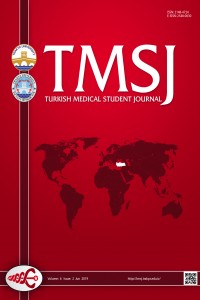Abstract
References
- 1. Choi HY, Son S, Jo HS et al. An infant with cerebellar tumor presenting with torticollis as the only initial symptom. Neurology Asia 2015;20(4):401-3.
- 2. Kumandaş S, Per H, Gümüş H et al. Torticollis secondary to posterior fossa and cervical spinal cord tumors: report of five cases and literature review. Neurosurg Rev 2006;29(4):333-8.
- 3. Ciftdemir M, Çopuroğlu C, Özcan M et al. Non-operative treatment in children and adolescent with atlantoaxial rotatory subluxation. Balkan Med J 2012;29(3):277-80.
- 4. Aladağ Çiftdemir N, Eren T, Çiftdemir M. A rare cause of torticollis: Grisel syndrome. J Trop Peiatr 2018;64(3):245-8.
- 5. Tomczak KK, Rosman NP. Torticollis. J Child Neurol 2013;28(3):365-78.
- 6. Fąfara-Leś A, Kwiatkowski S, Kawecki Z et al. Torticollis as a first sign of posterior fossa and cervical spinal cord tumors in children. Childs Nerv Syst 2014;30(3):425-30.
- 7. Turgut M, Akalan N, Bertan V et al. Acquired torticollis as the only presenting symptom in children with posterior fossa tumors. Childs Nerv Syst 1995;11(2):86-8.
- 8.Ouattasi N, Chmiel M, Kerouiti ZE. Acyte febrile torticollis in youth: clinical investigation and current management. Pan Afr Med J 2015;21(1):163.
Abstract
Aims: Torticollis secondary to a posterior fossa tumor is a rare condition that is mostly seen in pediatric patients. In this case
report, it is aimed to present a 23-month-old male patient with a posterior fossa tumor that presents the symptoms of torticollis.
Case Report: A 23-month-old male patient was admitted to the hospital with a history of a restricted range of motion in his
neck and leaning to his left side while sitting. Physical examination of the patient revealed acute onset of atlantoaxial rotatory
subluxation findings therefore, the initial diagnosis was Grisel’s Syndrome. Later, a cranial magnetic resonance imaging revealed
a mass which was seen in the posterior fossa. The mass was considered as the cause of the torticollis. Conclusion: This case report
shows the importance of the differential diagnosis of torticollis. Posterior fossa tumors should not be overlooked while searching
for the cause of torticollis. Keywords: Torticollis, posterior fossa tumors, infratentorial neoplasms
Keywords
References
- 1. Choi HY, Son S, Jo HS et al. An infant with cerebellar tumor presenting with torticollis as the only initial symptom. Neurology Asia 2015;20(4):401-3.
- 2. Kumandaş S, Per H, Gümüş H et al. Torticollis secondary to posterior fossa and cervical spinal cord tumors: report of five cases and literature review. Neurosurg Rev 2006;29(4):333-8.
- 3. Ciftdemir M, Çopuroğlu C, Özcan M et al. Non-operative treatment in children and adolescent with atlantoaxial rotatory subluxation. Balkan Med J 2012;29(3):277-80.
- 4. Aladağ Çiftdemir N, Eren T, Çiftdemir M. A rare cause of torticollis: Grisel syndrome. J Trop Peiatr 2018;64(3):245-8.
- 5. Tomczak KK, Rosman NP. Torticollis. J Child Neurol 2013;28(3):365-78.
- 6. Fąfara-Leś A, Kwiatkowski S, Kawecki Z et al. Torticollis as a first sign of posterior fossa and cervical spinal cord tumors in children. Childs Nerv Syst 2014;30(3):425-30.
- 7. Turgut M, Akalan N, Bertan V et al. Acquired torticollis as the only presenting symptom in children with posterior fossa tumors. Childs Nerv Syst 1995;11(2):86-8.
- 8.Ouattasi N, Chmiel M, Kerouiti ZE. Acyte febrile torticollis in youth: clinical investigation and current management. Pan Afr Med J 2015;21(1):163.
Details
| Primary Language | English |
|---|---|
| Journal Section | Case Report |
| Authors | |
| Publication Date | June 1, 2019 |
| Submission Date | May 14, 2019 |
| Published in Issue | Year 2019 Volume: 6 Issue: 2 |


